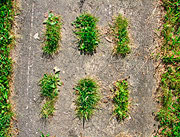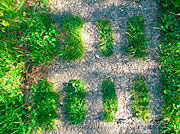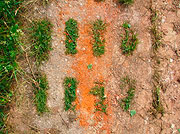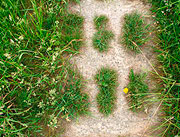

mittendurchsland
Photographs by Peter Schanz


The exhibition
mittendurchsland (straightthroughthecountry)
Photographs by Peter Schanz
Deep in the forest, where the borders of Bavaria, Saxony and the Czech Republic meet, a hiker picks up a trail, which 20 years ago, would have been highly visible even from outer space: the old border between the two Germanys and two worlds, at the time fortified with walls, barbed wire, automatic guns and minefields. The wanderer walks for almost three months and almost 1500 kilometers over mountains and through valleys all the way to the ocean. He meets people who live on both sides of this meandering junction; he hears about bitter disappointment and about great gratitude towards the course of history. He soon realizes there is much to learn, he needs to take more lessons on German history. And he has to put up with himself, his being over-weight, his backpack, his back pains – exhausting himself on personal issues and his country.
The path the wanderer follows is the convoy road which GDR border troops patrolled on, controlled and observed from: a strip – actually two strips – of cement panels, each three meters long and one meter wide, with a grid structure of seven lateral and four vertical rows, with 28 holes per panel. Sometimes the panels look as if they were just in use yesterday, well-kept, the cement as if brushed and sharp as a knife around the edges, free of weeds. Other times, the convoy road resembles a trail run to seed, un-kept, marshy and overgrown by an impenetrable, twenty-year old primeval forest. And again and again this sordid c-road – erected to shoot people easier who wanted to live out their constitutional rights to mobility – leads through wondrously lush and flourishing landscapes under a bright blue sky.
The wanderer absorbs the pictures that lie in front of him on his path: perforated cement panels in open nature. Eight holes per wink. The 1393-kilometer long-distance study on the German unification: what exactly did grass grow over? Who laid down these many hundred of thousands of panels? Who installed the fences, dug out trenches, placed the mines and constructed the automatic guns? Is a task less Herculean if it serves the means to bodily harm with fatal consequences? How quickly do I rid myself of the thought of walking along a former border? How quickly do I adjust, in my habit, in the daily routine, in a totalitarian system?
And how quickly do you clean all of this up? How fast did elsewhere extinct wildlife find a home here, where everything was forever contaminated by pesticides? And what conclusions should I draw, when our German nature is nowhere as intact as here, where it was severed the most?
bildkultur presents the series mittendurchsland
as an exhibition:
Size 700 x 1000 mm,
different sizes available on request
© Peter Schanz / bildkultur 2009
The artist
Peter Schanz
Peter Schanz was born in Bamberg, Germany. He studied German literature,
history and political science in Würzburg, Graz and Munich. Since
1984 he worked as a dramatic advisor and director at various German theatres,
from1997–1999 as artistic director at the 'Staatstheater Braunschweig'.
Since
1999 he has worked as a free-lance author and dramatic advisor.
www.peterschanz.de >>